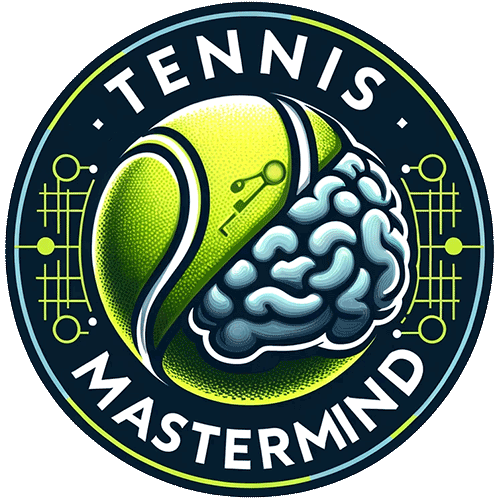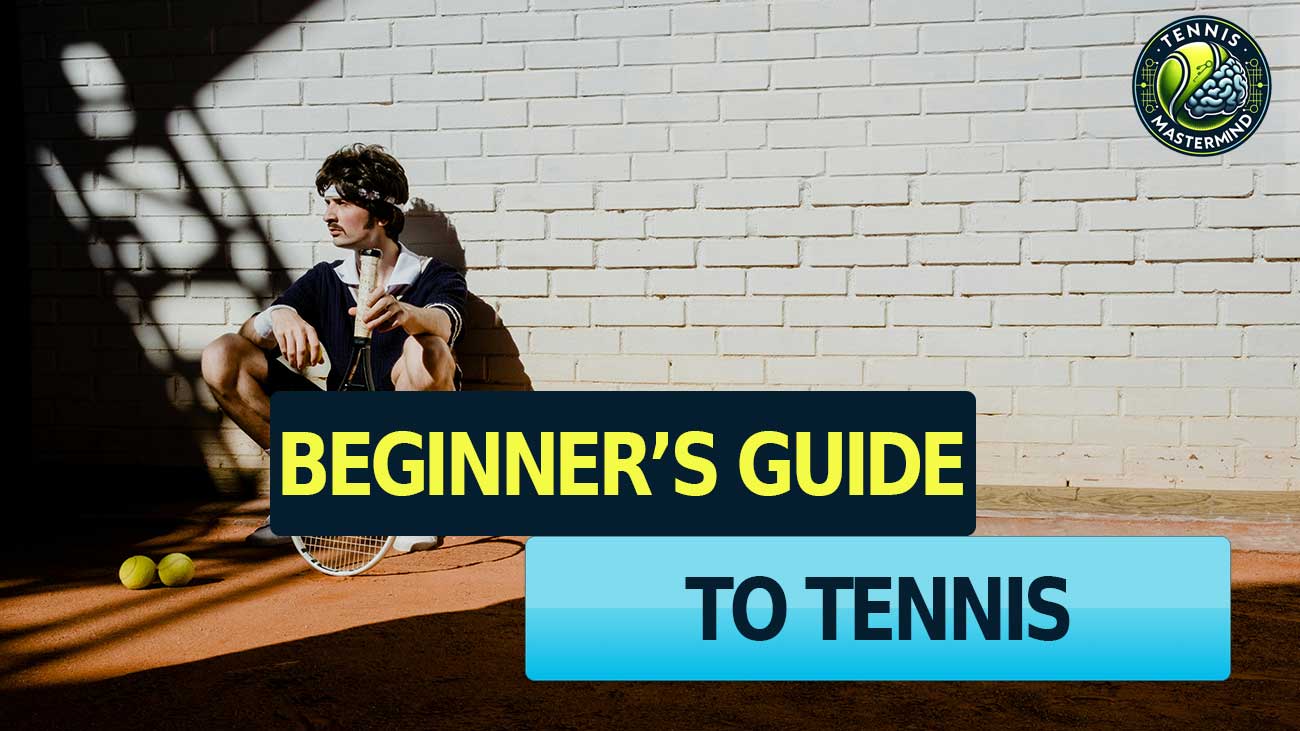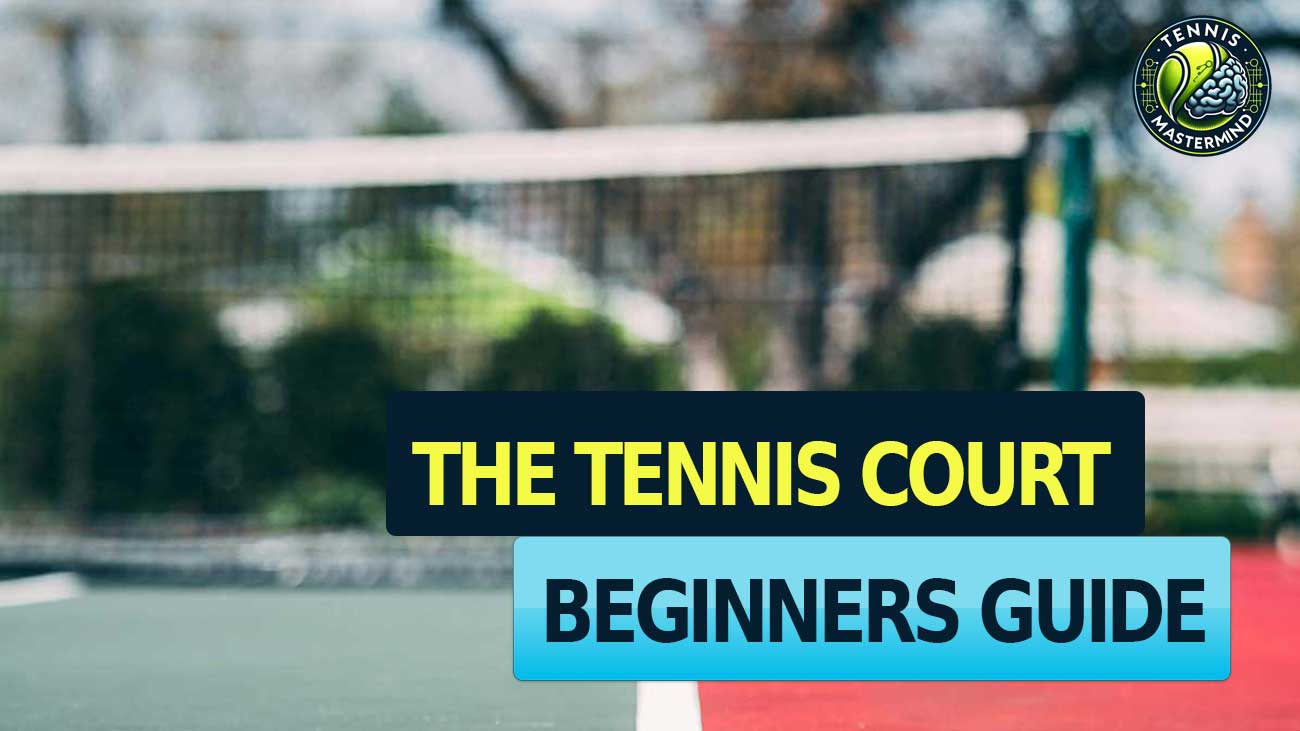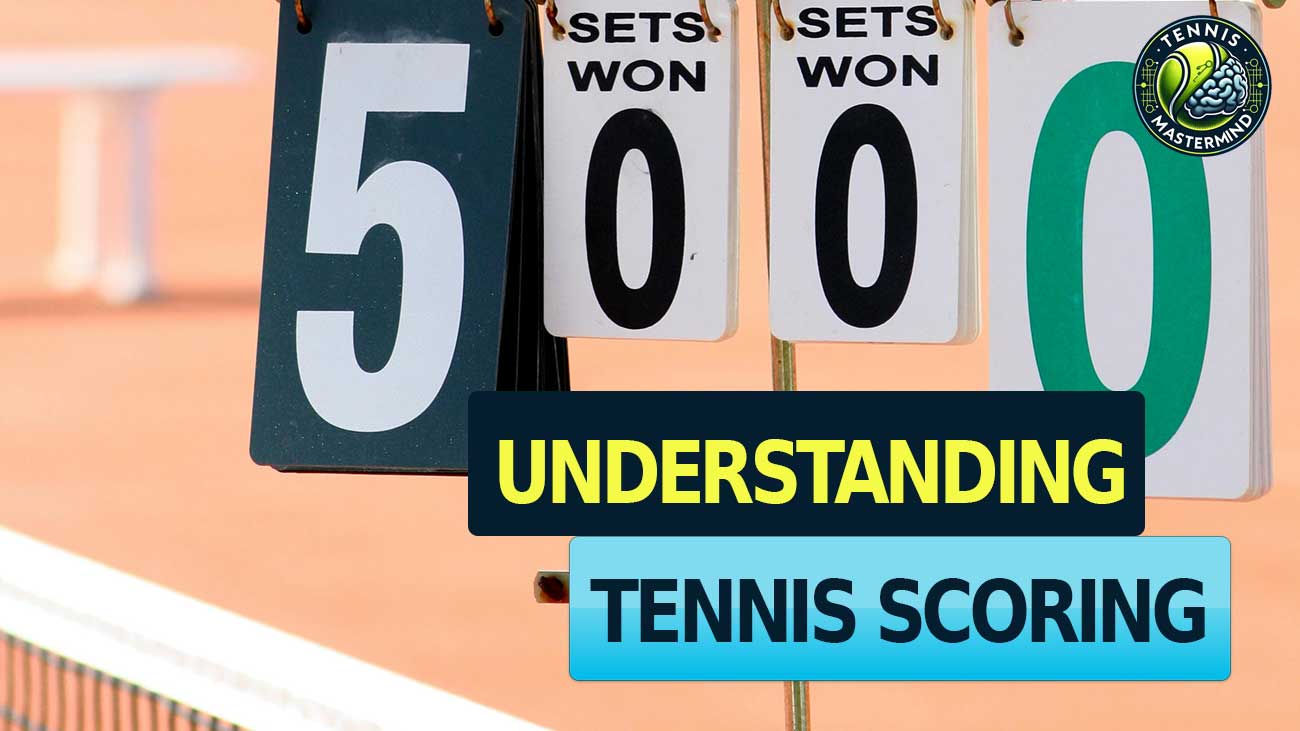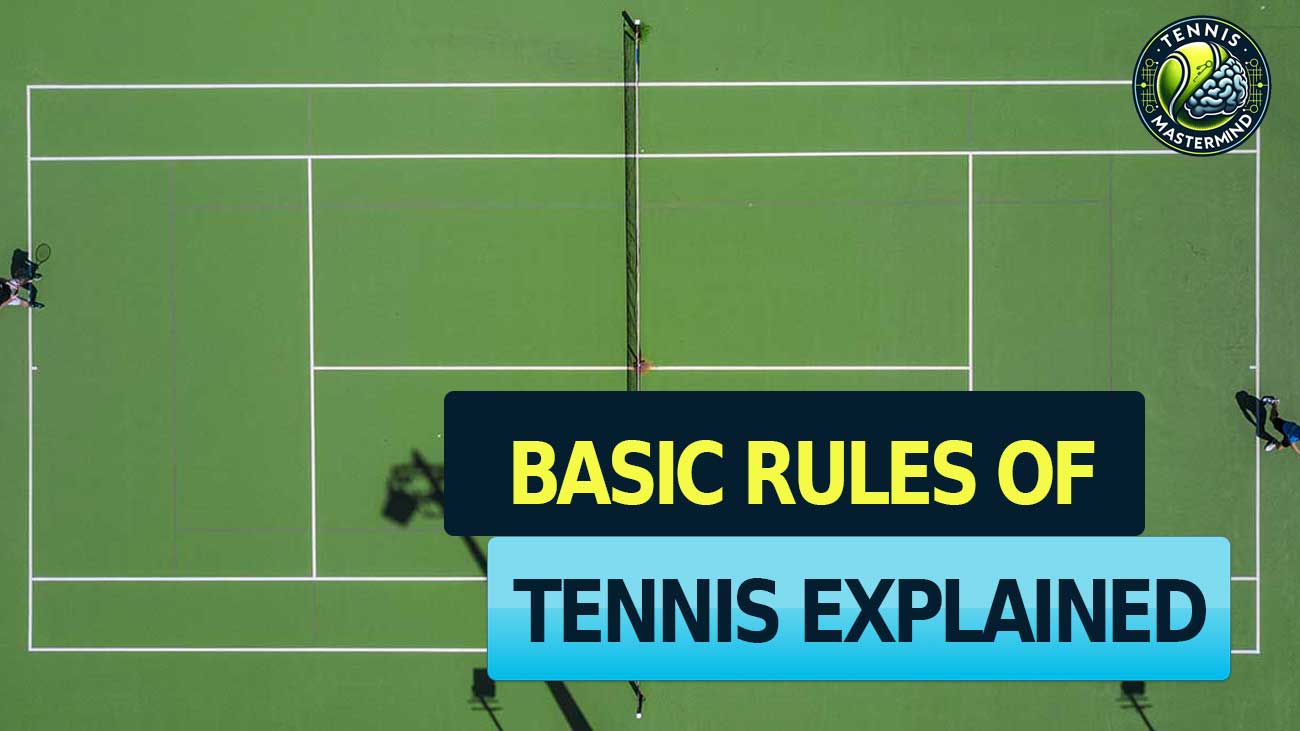Finding your way into the world of tennis can sometimes feel like learning a whole new language. Interestingly, this sport began as “jeu de paume” in the Middle Ages and has evolved significantly since.
This article promises to demystify tennis for you, simplifying its rules, equipment, and techniques. Let’s dive in — it’ll be fun!
Key Takeaways
- Tennis has a long history dating back to the Middle Ages, evolving from “jeu de paume” to the modern game played on various court surfaces.
- Scoring in tennis is unique with points starting at love (zero) and going up through 15, 30, and 40. Matches are made of sets that require a player to win six games by at least two.
- The right equipment is crucial for beginners; this includes choosing a suitable racket based on grip size, weight, balance point, string tension, flexibility, and length.
- Fundamental techniques like proper footwork, forehand, and backhand stances, adding spin to shots, transferring weight during swings, and mastering the follow-through are key skills.
- Implementing simple strategies such as keeping opponents moving and aiming for open areas can significantly enhance gameplay. Maintaining fitness tailored to tennis also improves performance.
Brief History of Tennis
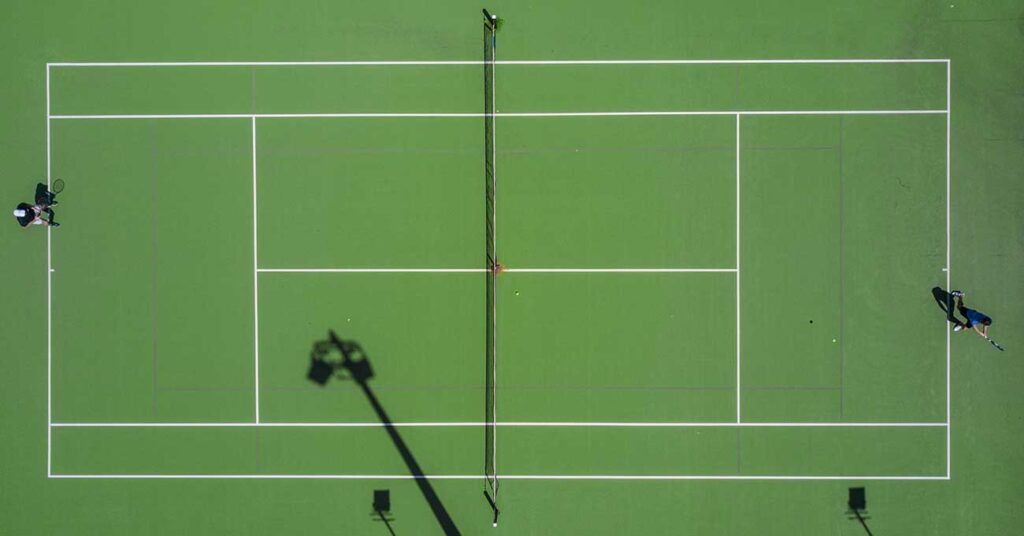
Tennis has traveled a long path from its origins to become the internationally loved sport it is today. It started as “jeu de paume” during the Middle Ages, a game played indoors where players hit a ball with their hands.
This early version planted the seeds for what would blossom into lawn tennis by the 19th century. A pivotal moment in tennis history came in 1874, thanks to Major Walter Clopton Wingfield.
He released a book that laid out rules for playing on outdoor grass courts, significantly boosting lawn tennis’s popularity.
As the game evolved, major tournaments and competitive play began shaping its modern form. Tennis made its Olympic debut in 1896, demonstrating its growing appeal and international recognition.
By 1926, professional tours were introduced, marking a new era where tennis players could compete globally for prestige and prizes. These steps forward have solidified tennis as not just a pastime but also a significant global sport followed by millions.
The Tennis Court: Basic Setup and Terminologies
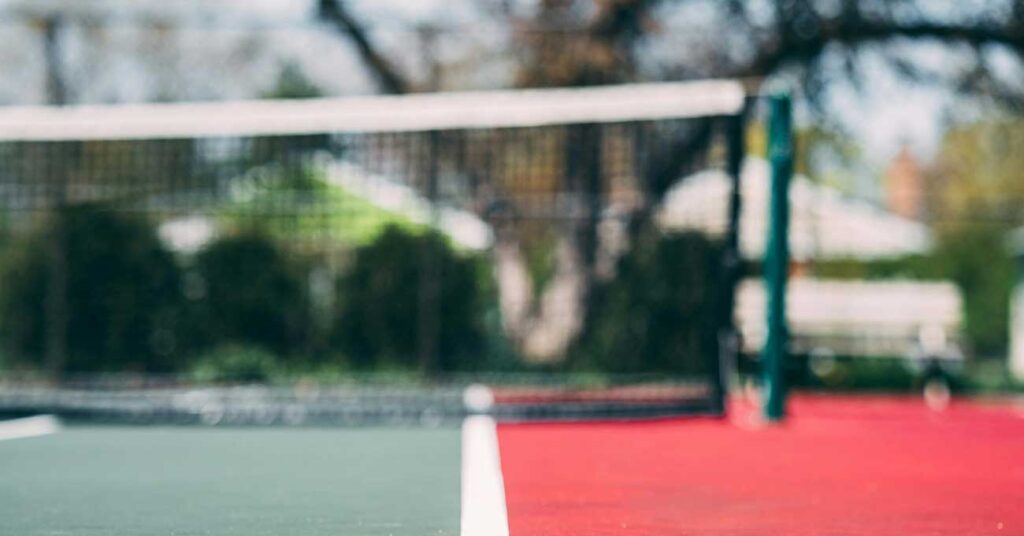
A tennis court is a rectangle with different zones for play. It has baselines at the back, service boxes close to the net, and sidelines that mark the boundaries. The court can be grass, clay, or hard surface.
Each type affects how balls bounce and players move. Key spots include the baseline, where players usually serve; service boxes, where serves need to land; and the net in the middle that divides both sides.
Players must hit the ball over the net into their opponent’s side without letting it bounce twice or go out of bounds. Learning these parts and lines helps you understand game rules better and plan your shots during matches.
Now let’s dive into understanding how scoring works in tennis—a system unique to this energetic sport.
Understanding the Rules of Tennis
Getting the hang of tennis rules can seem tricky at first, but they form the backbone of this exciting game—dive in to learn more and step up your game!
Scoring in Tennis
Scoring in tennis seems tricky at first, but it’s pretty straightforward once you get the hang of it. A game starts at zero, called “love.” The server’s score is always said first.
If a player wins a point, their score goes to 15. Win another, and it’s 30; win yet another for 40. To clinch the game, a player must win four points with at least a two-point lead.
Matches are made up of sets—win six games with a lead of two or more, and you win a set. Most matches are played as “best of three” or “best of five” sets. Understanding this foundation lets players track their progress and strategy during play without confusion over tennis scoring terms like “deuce,” which comes into play when both sides reach 40-40.
Deuce and Advantage
After getting a grip on scoring in tennis, understanding deuce and advantage becomes the next step to mastering the game. Deuce happens when both players hit a score of 40-40. This is where the game heats up—winning the next point after deuce gives a player “advantage.” However, if the opponent scores the next point, it’s back to deuce.
To win from advantage, a player must land one more point before their opponent does. If they succeed, they clinch the game. Fail to do so and you’re thrown back into the nail-biting scenario of deuce once again.
It’s a test of skill, quick thinking, and resilience that often decides who takes home victory in tight matches. This cycle continues until one player manages to outscore their opponent by two consecutive points — showcasing not just physical prowess but mental fortitude as well.
Tennis Equipment Essentials for Beginners
Starting in tennis? You’ll need the right gear—like a suitable racket and durable tennis balls—to hit the court running.
Tennis Rackets
Tennis rackets come in different types, each designed for a specific skill level. Beginners often find power racquets helpful because they add extra force to their swings. These racquets have larger heads and a lighter frame, making it easier for new players to hit the ball.
Intermediate players might lean towards tweener racquets, which offer a balance between power and control.
Choosing the right tennis racket involves considering your playing style and experience level. A heavier racket might provide more stability and control for powerful groundstrokes, while a lighter one could improve maneuverability for quick volleys.
The grip size is also crucial; it should fit comfortably in your hand to prevent injuries and ensure effective play. With the right tennis racket in hand, beginners can step onto the court with confidence, ready to develop their skills further.
Tennis Balls
After choosing the right tennis racket, the next step for beginners is to pick up a set of tennis balls. These are not just any balls; they’re designed specifically for the sport and play a crucial role in developing your game.
Beginners will use them in various drills to improve their coordination and hone their techniques. It’s about getting comfortable with the ball’s movement, understanding how to approach it, and mastering the timing needed to hit it back across the net.
These exercises often involve moving in different directions and catching or hitting balls fed from a racket. The goal is to familiarize players with how a tennis ball moves so they can get into position quickly and efficiently.
Practicing with these balls helps develop fundamental footwork skills that are essential for playing effectively on court. Moreover, working closely with tennis balls aids beginners in learning how far they need to be from the ball to make an accurate shot—key knowledge for anyone looking to improve their game.
Choosing the Right Tennis Racket for Beginners
Having the right tennis balls is essential, but equally important is selecting the appropriate tennis racket. This choice can significantly impact your game as a beginner. Here’s a guide to help you find the perfect match.
- Begin with Power Rackets – As outlined, power rackets are ideal for beginners. Their larger head size offers more hitting area, making it easier to connect with the ball and send it back across the net.
- Check the Grip Size – Ensuring the racket feels comfortable in your hand is crucial. A grip too big or too small can affect your control and might lead to injuries. You can measure your grip size by holding a racket in your dominant hand and seeing if there’s a small space between your fingers and palm.
- Consider Weight – Lighter rackets are generally recommended for starters because they’re easier to handle and maneuver. You don’t want to strain your arm before you’ve even gotten a good rally going.
- Balance Point Matters – A racket’s balance—whether it’s head-heavy, head-light, or evenly balanced—affects its feel and swing. Beginners often find an even balance that offers stability without being too hard on their arms.
- String Tension Is Key – While most beginner rackets come pre-strung, knowing about string tension is beneficial. Lower tension provides more power; higher tension offers greater control. Start with something in the middle range as you learn what works best for you.
- Ask About Flexibility – A stiffer racket transmits more force into the ball upon impact, while a more flexible frame absorbs it. Starting out, you may find that a bit of flexibility helps soften the learning curve.
- Choose Your Racket Length Wisely – Standard adult rackets usually measure 27 inches long. Longer rackets can offer extra reach on swings and serve but might be harder to control at first. Stick with the standard length until you develop your preferences.
Basic Tennis Techniques for Beginners
Mastering basic tennis techniques can transform you from a beginner to a proficient player quickly. Let’s dive into the essential skills that lay the foundation for your game.
Forehand and Backhand Stances
Tennis starts with good footwork. It’s crucial because a player should always move their feet during play.
- For a solid forehand stance, stand with your feet shoulder-width apart. This position gives you balance and the ability to move quickly.
- Turn your body sideways so your shoulder points towards the net. This way, you get more power when hitting the ball.
- Bend your knees slightly. It helps you stay ready to move in any direction fast.
- Hold the racket with a firm grip, but don’t squeeze too tight. Your arm should feel comfortable and ready to swing.
- Swing from low to high as you hit the ball. This motion adds spin and speed, making your shot stronger.
- Position your feet wider than shoulder-width. A wide stance provides stability for this two-handed shot.
- Turn your body so that both shoulders are parallel to the net. This position allows for more forceful swings.
- Grip the racket with both hands for better control and power. Your dominant hand should guide the movement.
- Keep your knees bent and your body low. You’ll be quicker and more responsive this way.
- Hit through the ball smoothly, transferring weight from the back foot to the front foot as you swing.
Adding Spin in Forehand and Backhand Shots
Mastering the forehand and backhand stances sets the stage for the next crucial skill in tennis—adding spin in your shots. This technique not only improves your game but it also adds an element of surprise. Here’s how to get started:
- Grip adjustment is key. To add topspin, rotate your grip slightly forward. This allows the racket to hit the ball at an angle, creating spin.
- Open your stance. Before hitting the ball, position your body so that you’re facing the net with feet shoulder-width apart. This posture helps generate more spin.
- Swing low to high. Aim to brush up against the ball rather than hitting it straight on. Imagine drawing a semi-circle with your racket from below the ball upwards.
- Increase racket head speed. The faster you swing, the more spin you’ll create. Practice accelerating your swing just before making contact with the ball.
- Follow through correctly. Extend your arm fully and finish your swing over your opposite shoulder to ensure maximum spin and better control over where the ball lands.
- Practice makes perfect—regularly work on these techniques to see improvement in both forehand and backhand spins.
- Use different types of balls during practice sessions; some may respond differently to spin, helping you understand how much force is needed.
- Lastly, always focus on wrist action—snap your wrist as you make contact for even more spin.
Weight Transfer and Follow-through
Weight transfer and follow-through are key to improving your tennis game. They boost both the power and accuracy of your shots, making them essential skills for beginners to master.
- Start with a solid stance: Your feet should be shoulder-width apart, knees slightly bent. This position gives you balance and readiness to move.
- Initiate weight transfer by leaning into your front foot as you prepare to hit the ball. This movement powers your shot from the ground up.
- As you swing, shift your weight from your back foot to your front foot smoothly. Imagine transferring energy through your body into the ball.
- Keep your eyes on the ball until contact is made. This focus is crucial for timing and precision.
- Follow through with your swing after hitting the ball. Your racket should continue in its arc, eventually pointing toward where you intend the ball to go.
- The follow-through should naturally end with most of your weight on your front foot, body facing the direction of your shot.
- Practice this motion without a ball first, focusing on fluid movement and proper form. Gradually introduce balls as you become comfortable with the mechanics.
- Consistency is key—repetition builds muscle memory that will improve your game over time.
Mastering the Forehand Stroke in Tennis
Mastering the forehand stroke in tennis takes practice and understanding. It’s a fundamental skill that can greatly improve your game.
- Start with your feet shoulder-width apart. Your stance is crucial—having a strong, balanced base helps you move quickly and hit the ball more effectively.
- Grip your racket properly. For beginners, the Eastern grip works best—it allows for flexibility and power in your shots.
- Keep your eye on the ball at all times. This sounds simple, but focusing on the ball helps you time your swing better.
- Turn your shoulders as you prepare to hit the ball. This motion helps generate power from your core, not just your arm.
- Step into the shot with your lead foot, transferring your weight forward as you hit the ball. This movement adds force to your swing, making the ball travel faster.
- Hit the ball in front of you—not too high or low—to maintain control and precision over where it goes.
- Follow through with your swing, letting your racket finish over your opposite shoulder. A complete follow-through ensures maximum power and accuracy.
- Practice catching and throwing a tennis ball to improve hand-eye coordination, an essential skill for mastering the forehand stroke.
Tennis Strategy and Tactics for Beginners
To play better tennis, beginners must grasp simple strategies and tactics. Knowing where to stand and how to move can change the game. A good tactic is to keep your opponent moving.
Hit the ball to different sides of the court so they can’t guess where it’s going next. Also, using drop shots makes them run forward after moving back for your previous shots.
Practice these basics often; it will make you stronger on the court. Learning when to use a powerful shot or a soft touch comes with practice too. Always aim for open areas of the court, forcing your opponent to cover more ground.
This approach not only puts pressure on them but also opens up opportunities for winning points.
Next, let’s dive into tennis-specific fitness and conditioning tips that will help elevate your game even further.
Tennis-Specific Fitness and Conditioning
Tennis demands a lot from your body. Every muscle group must work in harmony for long stretches of time. To meet these demands, specific fitness and conditioning are key. This includes exercises that boost stamina, strength, and agility.
You’ll be running, stopping quickly, and changing direction often during a game. So, it’s important to have good cardiovascular health as well as strong legs and core muscles.
Practicing regularly not only sharpens your technique but also enhances your physical condition. Improved strength leads to powerful shots while endurance helps you last longer on the court without getting tired.
Plus, the mental benefits are huge—playing tennis can reduce depression and increase energy levels significantly. Now that we’ve covered how to stay fit for tennis, let’s explore some helpful tips for beginners stepping onto the court for the first time.
Tips for Beginning Tennis Players
After focusing on fitness and conditioning, it’s time to dive into some practical tips for beginning tennis players. These suggestions will help you improve your game and enjoy your time on the court even more.
- Start with the basics—learn how to hold a racket properly. A comfortable grip is essential for controlling your shots and adding power without straining your wrist.
- Practice footwork drills regularly. Good footwork improves your balance, speed, and ability to reach the ball, making it a cornerstone of successful play.
- Use free online lessons provided by reputable sources like the International Tennis Federation (ITF). They offer valuable insights into fundamentals and techniques for beginners.
- Focus on mastering the forehand stroke first. It’s one of the most common shots in tennis and serves as a foundation for developing other skills.
- Incorporate step-by-step exercises that include catching and throwing the ball. This enhances coordination, an important aspect of tennis often overlooked by beginners.
- Schedule regular practice sessions. Consistency is key in improving not just your physical ability but also your mental sharpness on the court.
- Experiment with different tennis rackets until you find one that suits your style of play—the right equipment can make a significant difference.
- Pay attention to adding spin in forehand and backhand shots; this technique makes it harder for opponents to predict and return shots effectively.
- Work on weight transfer and follow-through in each shot; these elements are crucial for increasing power and accuracy in your game.
- Be patient with yourself during the learning process; improvement takes time, effort, and persistence, but it leads to greater enjoyment and success in tennis.
- Seek feedback from more experienced players or coaches whenever possible—they can offer specific advice tailored to enhance your skills further.
Conclusion
Tennis, with its rich history and wide appeal, offers something for everyone. Whether you’re chasing the thrill of competition or the joy of new friendships, it’s a game that rewards both your physical and mental prowess.
Diving into tennis means embarking on an exciting journey towards improved fitness and sharper strategy skills. Every swing brings you closer to mastering this beloved sport. Let the adventure begin!
FAQs
1. What are the grand slam tournaments in tennis?
Grand Slam tournaments — think of them as the big, must-watch events in tennis. They’re made up of four majors: Wimbledon, the US Open, the French Open, and the Australian Open. These are where stars shine brightest on the court.
2. Can playing tennis improve my health?
Absolutely! Tennis isn’t just fun; it’s a full-body workout that boosts both your physical health and mental well-being. You’ll be running, stretching, and strategizing — which means your brain gets a good workout too.
3. What is The Lawn Tennis Association?
The Lawn Tennis Association plays a big role in tennis across ponds – they’re like guardians of the sport in Britain., making sure players have all they need to serve and volley at their best.
4. Is there privacy when I sign up for tennis e-mails or use websites with third-party cookies?
Here’s where it gets techy — yes, you might notice those pesky third-party cookies tracking how you surf online or even when receiving e-mails about next weekend’s game… But remember! Great efforts are put into protecting your privacy so you can focus more on backhands and less on data breaches.
5. Do beginners play in special competitions like Davis Cup?
Okay, starting, no pressure to jump straight into something as prestigious as the Davis Cup — that’s reserved for top-notch national teams. However, don’t let that stop your ace spirit! There are plenty of beginner-friendly matches and clinics designed to get you match-ready, Who knows? Maybe one day…,
